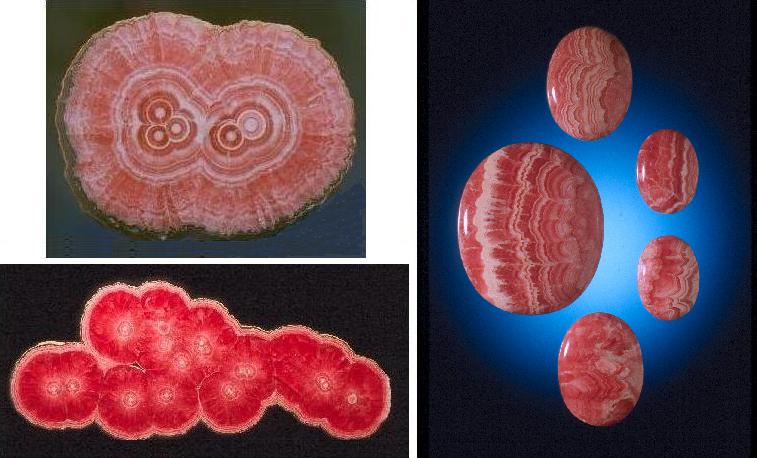( Fr- rhodochrosite; Ger- Rhodochrosit;
Nor- rhodokrositt; Rus- ![]() )
)
RHODOCHROSITE, MnCO3.

A. Rhodochrosite (top left) honed surface (width - 8.4 cm) from Catamarca, Argentina. Canadian Museum of Nature. (© photo by Jeffrey A. Scovil)
B Rhodochrosite (bottom left) polished surface (width - 42.2 cm) from Catamarca, Argentina. Martin Zinn collection. (© photo by Jeffrey A. Scovil)
C. Rhodochrosite (right side) cabochons (largest one, greater axis - 6.0 cm). Rincon Minerals. (© photo by Jeffrey A. Scovil)
DESCRIPTION:OTHER NAMES:
USES: Beads; cabochons and freeforms
for pendants,
brooches etc.; spheres,
eggs, hearts and carvings; along with other gemrocks
-- such as lapis lazuli, malachite and sugilite -- in some fine quality
intarsia (gemstone inlay) pieces; also as specimens for use as
show pieces. Both the larger gemstones and show pieces that are
preferred by most people are those cut at approximately right angles to
the lengths of the stalagmitic material --
see Figures A & B.
A large
(10.875 kg = ~24 lb; greatest dimension 21.60 cm = ~ 8 1/2 in)
carving "in the form of Lord Mahaveera, one of the ancient Indian sages
who established the tenets of Jain Dharma" is described and
shown in four photographs by Choudhary and Vyas (2011)
OCCURRENCES: Rhodocrosite has diverse geneses and occurrences. Most of the gemrock material of Argentina occurs as crusts or virtually complete fillings of preexisting fractures and as matrices of breccias that are spatially associated with zones of sulfide mineralization -- so, this rhodochrosite is, in a sense, a gangue mineral of sulfide deposits. Some of the finer quality masses, however, have so-to-speak stalagmitic growth patterns and shapes (see Figures A and B).
NOTEWORTHY LOCALITIES: Much of the massive gemrock rhodochrosite rough that is available in the marketplace comes from localities along the eastern side of the mountains of western Argentina; the copper-rich Capillitas bed in Andalgala County, Province of Catamarca has been especially productive. Shigley et al. (2000) tabulate localities and pertinent references for localities from which rhodochrosite used as a gemstone was recovered during the 1990s.; gemstone is used here because these figures include coarsely crystalline rhodochrosite -- i.e., gem mineral rhodochrosite -- that has been, for example, faceted.
REMARKS: The name rhodochrosite is
from the Greek ῤοδοχρωϛ (ῤοδο - rose + χρωϛ
-
color). It is said the inca rose designation is based on
the "fact" that some of it comes from stalctitic and stalagmitic
growths in silver mines worked by the ancient Incas.
So far as I know, rhodochrosite has not been
recorded as having been subjected to enhancement procedures. I
suspect, considering its brittleness, that some lapidaries may have at
least attempted to impregnate it.
As noted in the RHODONITE entry, for a while during the 1950s pink and black became so-to-speak fad colors, especially for men -- e.g., they/we wore pink shirts, black ties, etc., and, during that period, rhodonite, with its pink and black colors, was popular in jewelry such as tiepins and large cuff-links. However, a few pieces used during that period were fashioned from combinations of rhodochrosite and black onyx; and some rather attractive jewelry -- e.g., necklaces and bracelets -- made up of these two gemrocks continues to be marketed rather widely.
Rhodochrosite was approved as the official state mineral of Colorado by the state representatives and senators and signed by the governor on April 17, 2002. The rhodochrosite that led to this action is not, however, that herein described as gemrock; it is the "highly prized red rhodochrosite crystals from the Sweet Home mine [which] tops the list of desirable gems from the state" (Murphy and Modreski, 2002).
SIMULANTS:
Banded calcite -- e.g., onyx marble --
dyed pink.
- [inferior hardness (H. 2) and lower specific gravity].
Talc-calcite aggregate - talc is the source of
the color
(i.e., the caclite is Manganese-free). - [lower S.G. (2.73)].
See Federov (2002).
REFERENCE: Saadi and Grasso, 1992.
R. V. Dietrich © 2015
Last
update: 14 November 2011
web page created by Emmett Mason